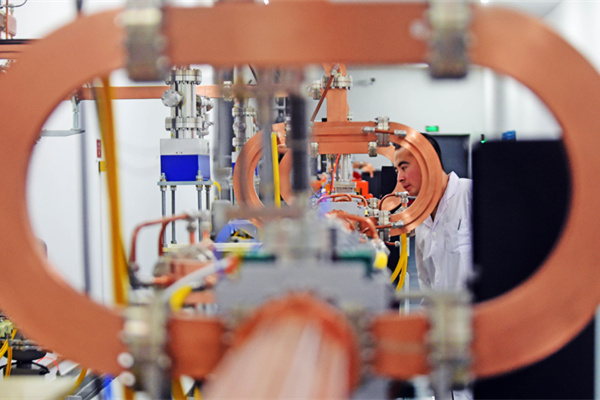
A researcher from the Chinese Academy of Sciences examines the Dalian Coherent Light Source. (Photo/Xinhua)
Chinese scientists have built the brightest extreme ultraviolet light in the world for capturing atoms and molecules that will reveal laws of the micro-material world.
The Chinese Academy of Sciences announced on Sunday that they have successfully developed the Dalian Coherent Light Source, which can generate the brightest extreme ultraviolet free-electron laser light.
"We expect the new facility will become a new machine for important scientific discoveries and international scientific collaborations," said Zheng Yonghe, director of the policy bureau at the National Natural Science Foundation of China, which funded the organization of the project.
Most physical-chemical processes that take place in our daily lives, such as the formation of pollution haze, essentially involve changes of atoms and molecules. As a result, scientists need tools that can help the mob serve the movement of atoms and molecules so that they can understand or even utilize these physical-chemical processes.
"That is why we need to develop free-electron laser light sources, which have wide applications in the study of basic energy science, chemistry, physics and atmospheric sciences," said Yang Xueming, deputy director of the academy's Dalian Institute of Chemical Physics and a member of the academy.
In order to catch fish in deep water, fisherman usually fish at night, using a bright light source to attract both the fish and members of their food chain.
When smaller fish, insects or shrimp swim toward the light and the big ones follow them, they are harvested in one clean sweep.
Like the light that attracts fish to the surface of the water, free-electron laser light can charge up atoms and molecules and expose them to electromagnetic detectors.
A series of high-gain free-electron laser light source facilities in the X-ray and soft X-ray region-a special energy band of light wave-have been successfully developed across the world.
However, free-electron laser light sources in the energy band of extreme ultraviolet-a band with lower energy than X-ray or soft X-ray-have not been developed, Yang said.
"Extreme ultraviolet free-electron laser light sources are especially useful for sensitive detection of atoms, molecules and clusters as well as probing valence electronic structures of all kinds of materials," he said.
The Dalian Coherent Light Source was collaboratively developed by the academy's Dalian Institute of Chemical Physics, Institute of High Energy Physics and Shanghai Institute of Applied Physics; the University of Science and Technology of China; and Tsinghua University.


















































